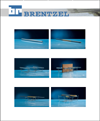A transverse joint frequently crossed by heavy goods traffic tends to form steps if it not perfectly doweled. This is associated with negative effects on ride comfort and driving safety as well as damaging after-effects to the concrete pavement.

In general, DOWELS are required in transverse joints to transfer load and to ensure the slabs are at the same level and TIE BARS are required in longitudinal joints to prevent the slabs from wandering apart. Dowels and tie bars are mandatory for concrete pavements designed to construction classes BK3,2 to BK100 in accordance with ZTV Beton-StB 071.
Apart from adequate dowel diameter, correct, durable dowelling requires the smallest possible pull out resistance. Furthermore, the dowel must have effective protection against corrosion. According to TL Beton-StB 07², dowels with a diameter of 25 mm and a length of 500 mm must be used. The whole length of the dowel must be covered with a very adherent alkali resistant plastic coating, at least 0.3 mm thick. Deformation of the dowel ends on cutting to length is to be avoided to ensure free mobility of the concrete slabs.
The dowels must be laid in the middle of the slab pavement so that they do not impede expansion of the slab. The dowels are usually vibrated directly into the fresh concrete by modern slip form pavers. In many cases, however, it is necessary to lay the dowels out in the correct position on an underlay before concreting. Here the problem is the additional work and maintaining the precise position of the dowels during subsequent concreting. We have developed a holder to ensure the dowels and tie bars stay in the correct position. The holder’s functional performance has been appropriately verified through tests and practical trials.
The distribution of the dowels within the cross-section of the carriageway lanes is of considerable importance for the performance of the concrete pavements under use conditions. The dowel spacing for highly trafficked carriageway lanes is 25 cm.
Exemplary dowel allocation, profile in accordance
with ZTV Beton-StB 07.
Performance standard A: normal trafficked lanes
Performance standard B: highly trafficked lanes
Performance standard C: Breakdown lane
In accordance with ZTV Beton-StB 07 the dowel spacing for all lanes is always 25 cm if the construction classes are BK32 to BK100. After that the performance standard is always B1.

Tie bars are normally 20 mm in diameter and 800 mm long. The middle section (joint) of the tie bars are also coated with approx. a 0.4 mm thick plastic coating over a length of 200 mm to protect against corrosion.
Standard, threaded tie bars or adhesive tie bars are used for the anchorage. In the longitudinal direction, three tie bars per slab must be laid at uniform spacing on straight sections of road. The number of tie bars in longitudinal compression joints (construction joints) must be increased to five in pavements designed to construction classes BK3,2 bis BK100. This achieves greater transfer of transverse (shear) forces. In longitudinal contraction joints the tie bars are laid in the bottom third of the pavement slab and in the middle of the pavement slab in longitudinal compression joints.
1 ZTV Beton-StB = German additional technical conditions of contract for concrete road pavements
2 TL Beton-StB 07 = German technical conditions for construction materials for concrete road pavements


 Deutsch
Deutsch Polski
Polski
Comments are closed.